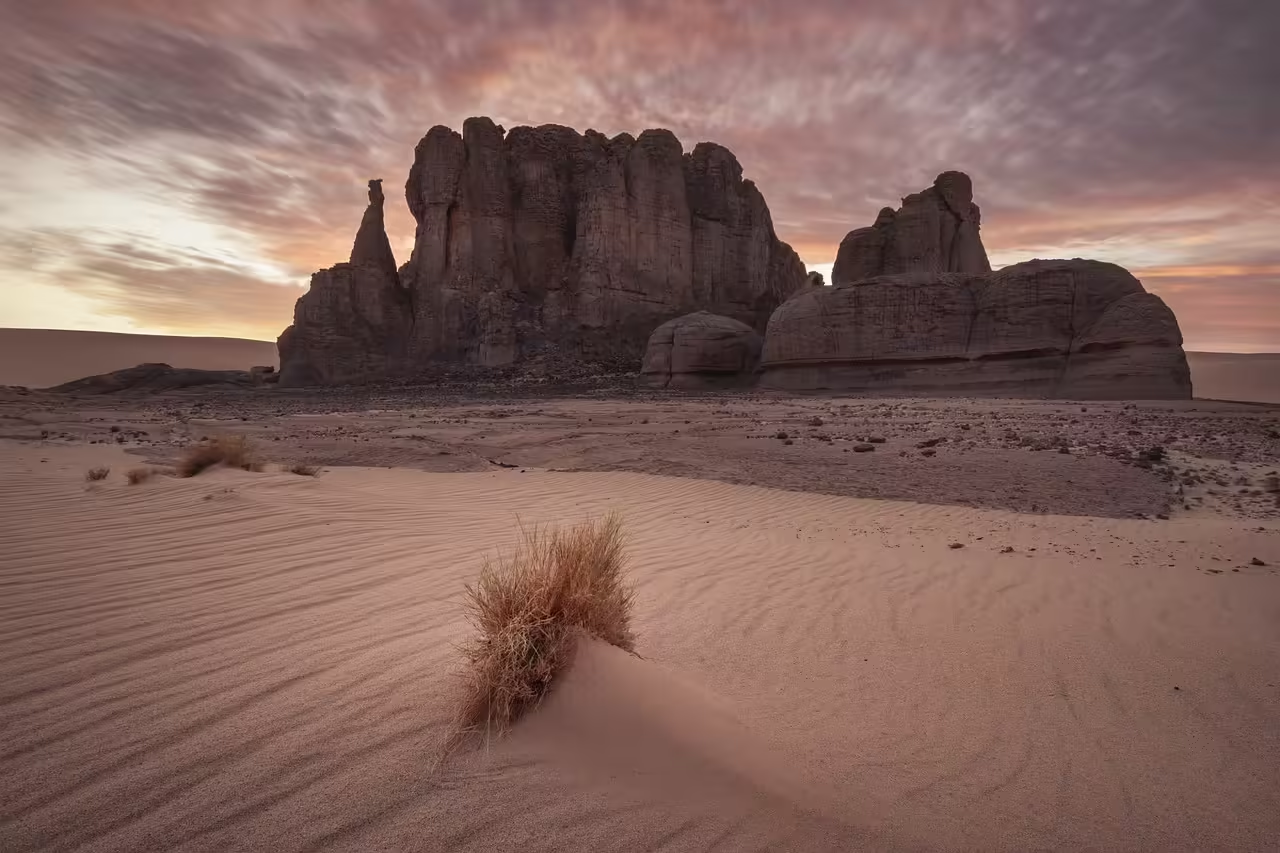Sahara Desert in Algeria
The Sahara Desert in Algeria: A Landscape of Life, Culture, and Resilience
The Sahara Desert in Algeria stands as one of the most captivating and remote regions on Earth. Covering a vast portion of the country, this part of the Sahara reveals a diverse tapestry of landscapes, from sweeping sand dunes to rocky plateaus and isolated mountain ranges. Despite its reputation for harshness, the Algerian Sahara offers a vibrant and dynamic environment where life continues to flourish.
A Living Desert with Nature and Culture Intertwined
Life in the Algerian Sahara has evolved in harmony with the desert’s demanding conditions. Far from being barren, the region supports communities, wildlife, and traditions that have adapted over centuries. Visitors often find themselves surprised by the richness of culture and the resilience of those who call the desert home.
Many of the people living in this region speak Berber or Arabic, with the Tuareg being among the most well known groups. Their striking indigo garments, which help protect against the sun, have become a symbol of identity and pride. The Tuareg have long navigated the desert in search of water and grazing land, following ancient routes that once connected Africa’s interior to the Mediterranean coast.
Although some have settled in permanent communities, many still maintain a semi-nomadic lifestyle. Their connection to the land remains strong, and their cultural practices continue to reflect a deep understanding of the desert’s rhythms.
Desert Towns and Oases
Towns and oases play a vital role in sustaining life across the Algerian Sahara. These hubs offer essential resources and serve as meeting points for trade, culture, and community. Among the most prominent towns are Tamanrasset, Djanet, and Timimoun.
Tamanrasset, located in the heart of the Ahaggar Mountains, has grown into a lively centre for both local residents and travellers. Its markets brim with traditional crafts, jewellery, and goods that reflect the region’s heritage. The town also acts as a logistical base for those exploring the surrounding desert.
Djanet, situated near the Tassili n'Ajjer plateau, draws attention for its dramatic landscapes and ancient rock art. Researchers and tourists alike visit to witness the area’s natural beauty and historical significance. Timimoun, known for its red-hued architecture and palm groves, offers a peaceful retreat and a glimpse into oasis life.
These towns do more than provide shelter. They foster cultural exchange and support the desert’s economy. Their presence allows communities to thrive in an otherwise challenging environment.
Oases: Sustaining Life in the Sahara
Oases are essential to survival in the Sahara Desert in Algeria. These green pockets, often surrounded by palm trees and date groves, support agriculture and provide water for both people and animals. Dates, in particular, serve as a staple food and a valuable trade item. Harvesting them is a communal activity that strengthens social bonds and sustains livelihoods.
The existence of oases has enabled communities to develop a degree of self-sufficiency. Small plots of land are cultivated with care, and water is managed with precision. These efforts reflect a deep respect for the environment and a commitment to sustainable living.
Wildlife in the Algerian Sahara
Despite the extreme climate, the Sahara Desert in Algeria supports a variety of wildlife. While large animals are rare, smaller species have adapted remarkably well. The fennec fox, with its oversized ears, thrives in the heat. Desert hedgehogs and numerous bird species also find refuge in this sparse landscape.
Camels, often called the “ships of the desert,” remain the most iconic animals in the region. Their ability to endure long journeys without water makes them indispensable for transport and trade. Communities rely on camels not only for movement but also for milk, meat, and companionship.
These animals illustrate the desert’s ability to nurture life, even under the most demanding conditions.
Cultural Expressions
Culture in the Algerian Sahara is rich and deeply rooted in tradition. Music, storytelling, and craftsmanship form the backbone of social life. Gatherings around campfires often feature songs that recount tales of the desert, journeys, and shared experiences.
Tuareg music, known for its hypnotic rhythms and poetic lyrics, offers insight into the values and history of desert communities. Instruments such as the imzad, a single-stringed bowed instrument, create haunting melodies that resonate across the dunes.
Craftsmanship also plays a central role. Artisans produce silver jewellery, leather goods, and textiles that carry both practical and symbolic meaning. These items reflect personal identity, social status, and cultural heritage. The indigo garments worn by many desert dwellers serve not only as protection from the sun but also as a statement of pride and belonging.
Tourism and Discovery
Tourism in the Sahara Desert in Algeria continues to grow, attracting those eager to explore its vast landscapes and cultural depth. Visitors come to experience natural wonders like the Tassili n'Ajjer, a UNESCO World Heritage Site known for its sandstone formations and ancient rock art. Some of these artworks date back thousands of years and offer a glimpse into early human life in the region.
The Ahaggar Mountains, with peaks such as Assekrem, provide opportunities for trekking and reflection. These rugged terrains offer a sense of isolation and serenity that appeals to many travellers.
Guided tours, often led by local experts, help visitors understand the desert’s complexities. Camel treks, overnight stays in traditional tents, and visits to remote communities allow for immersive experiences. These activities foster appreciation and respect for the people and landscapes of the Algerian Sahara.
Sustainability and Community Engagement
Sustainable tourism plays a key role in preserving the Sahara Desert in Algeria. Responsible travel practices help protect fragile ecosystems and support local economies. Many tour operators now prioritise environmental stewardship and cultural sensitivity.
Community involvement is also essential. Local residents participate in tourism initiatives, offering services, sharing knowledge, and guiding visitors. This approach ensures that tourism benefits everyone and strengthens the connection between guests and hosts.
Education and awareness are central to these efforts. Visitors learn about water conservation, desert ecology, and cultural traditions, gaining a deeper understanding of the challenges and triumphs of desert life.
A Desert of Depth and Meaning
The Sahara Desert in Algeria is far more than a sea of sand. It is a living, breathing environment where people, animals, and traditions coexist in harmony. The desert’s beauty lies not only in its landscapes but also in the resilience and creativity of those who inhabit it.
For travellers seeking connection, discovery, and reflection, the Algerian Sahara offers a journey unlike any other. Its stories, sounds, and sights leave a lasting impression, inviting visitors to see beyond the surface and appreciate the richness within.

